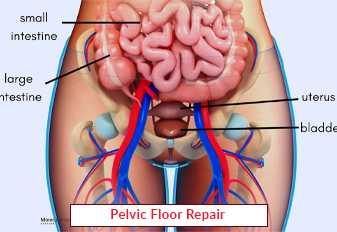Pelvic floor repair treatment is a medical procedure. It is used to restore the functioning of pelvic organs or pelvic floor dysfunction in women. The treatment is suggested by the doctors to patients who are suffering from pelvic muscle and ligament-related health concerns. Mostly the problem occurs in females due to childbirth and various chronic conditions.
The pelvic floor repair treatment assists doctors to restore the functioning of the pelvic and the other related organs including rectum, bladder, vagina, and uterus in females. The surgical procedure is performed under general anesthesia in a hospital under the consultation of experienced gynecological surgeons and the team of medical experts. The pelvic floor repair surgery usually takes 2 to 3 hours however, surgery duration may vary depending on the complications.
Symptoms of Pelvic Floor Prolapse
Here are the common symptoms of pelvic floor prolapse. These are as follows:
- Experiencing pain during sex.
- Feeling like a ball stuck into the vagina.
- Having problems while pee and poop.
- Frequently experiencing pee or leakage.
- Feeling a lot of pressure in your pelvic and lower back.
- Bowel problems
- Discomfort while sitting and standing.
What Conditions Does Pelvic Floor Repair Treat?
Various prolapses are depending on the organ involved these include:
- Enterocele: In this condition your intestine bulges into your vagina wall. It is also a type of pelvic organ prolapses mostly occur due to pregnancy or childbirth.
- Vaginal Prolapse : When your vagina vault drops down your vagina canal this condition is called vaginal prolapse. Mostly occurs in people who have gone through vaginal hysterectomy treatment.
- Uterine prolapse: In this condition the uterus and the cervix drop down the vaginal canal sometimes as much that they go past the opening of the vagina.
- Cystocele: This occurs when your bladder bulges inside the vagina.
- Rectocele: Here your rectum bulges inside the vagina.
Reasons to Undergo Pelvic Floor Repair
The following are the main causes and reasons to repair pelvic floor.
- Genetic Factors
- Heavy weightlifting
- Chronic cough
- Aging
- Menopause
- Vaginal childbirth
- Pelvic organ surgery
- Neurological conditions
Pelvic Floor Repair Surgery Procedure
The pelvic floor repair surgery procedure done through the following steps which are given below:
- Firstly, the doctor will give you general anaesthesia so you can feel relaxed during the surgery procedure and not feel pain.
- Then an operating surgeon will make four to five incisions in your lower stomach in the abdomen part.
- Then the surgeon will inflate your abdomen with corban dioxide to make space to perform the surgery.
- Then the surgeon will start inserting a laparoscope which is a thin telescope kind of tube attached with a tiny camera.
- After that the surgeon attaches a piece of surgical mesh to the top and bottom walls of your vagina and then to the sacrum. This suspends the top of the vagina or cervix back into its actual position.
- If the surgeon does not find enough support for your bladder or rectum then the surgeon will repair these two as well.
- If you’re suffering with urinary incontinence, then the surgeon will place a small piece of mesh underneath your urethra to give you support while you laugh, cough and sneeze.
- Lastly, at the end of the surgery the surgeon will carefully view inside your bladder with a small camera to ensure it wasn’t damaged during surgery.
- Finally, the operating surgeon gently removes all the instruments from the abdomen part and closes all the incisions through stitches.
Risks Associated with Pelvic Floor Repair
The risks and complications that are associated with pelvic floor repair treatment are as follows:
- Infection
- Bleeding
- Hernia
- Urinary Retention
- Adjacent tissue
Estimate Cost of Pelvic Floor Repair
Pelvic Floor repair surgery costs range from 80,000 to 1,50,000 INR, but it depend on several factors including location of the hospital, doctor’s experience, and the complications that are present in the case. However, there are several benefits of availing the treatment such as it reduces the discomfort and pain, and restores the functioning of different organs that are linked with the pelvic organ.
Recovery Tips and Period
A healthcare provider suggests following a few guidelines to recover sooner. You will also recommend walking for at least 10 to 15 minutes on a regular basis. Take a follow up from your consulted doctors. Proper resting and having a good nutrition rich diet also comes in guidelines. However, the recovery period usually takes four to six weeks’ time according to the doctors. Once you recover from the surgery you can return to your normal routine.
Latest Health Tips
Can Immunotherapy Cure Stage 4 Lung Cancer?
Early Signs of Cervical Cancer
Foods that Kill Cancer: Leafy Vegetables, Grains, & More
What Stage of Cancer is Immunotherapy Used For?
Which is Worse for Cancer, Sugar or Alcohol?
Vaccines That Prevent Cancer
What Kills Cancer Cells in the Body Naturally?
5 Early Warning Signs of Bone Cancer
Submit Your Enquiry
Testimonials


























